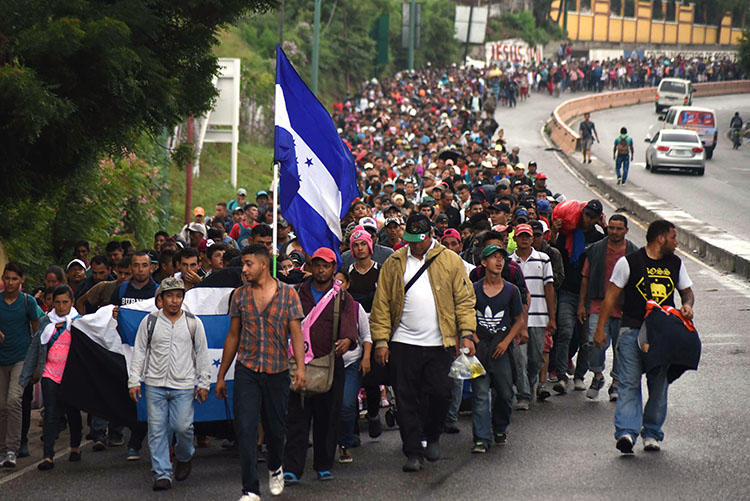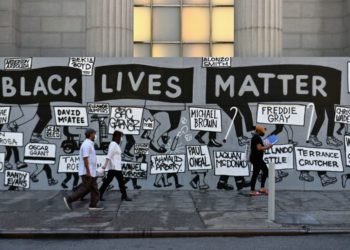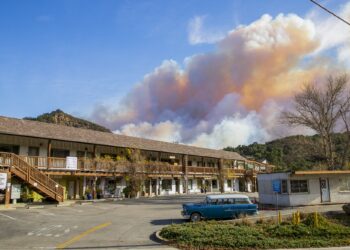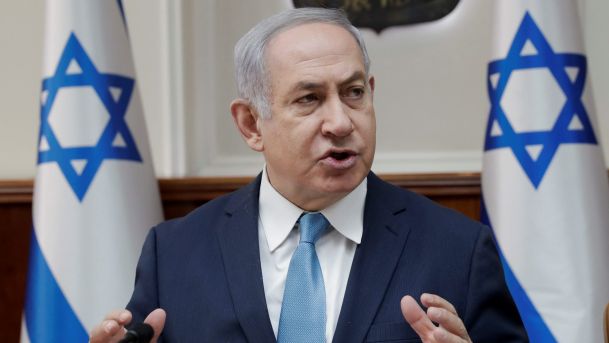During the first Democratic presidential debates in June, several candidates alluded to addressing the root causes that are driving families from Central America’s Northern Triangle to make the nearly 2,000-mile journey to the United States.
But the candidates have so far only glossed over these causes, referring vaguely to high levels of violence, hopeless poverty, and the persistent threats from criminal gangs that many in Guatemala, El Salvador, and Honduras face.
Proposed solutions have been more vague, with candidates promising increased “investment” and “opportunity.” But if the United States is serious about helping to address the underlying causes of migration, it may have to consider a broader reorientation of its foreign policy towards the region.
In Honduras, U.S.-backed right-wing President Juan Orlando Hernandez has faced mass demonstrations calling for his ouster in recent weeks. What started as a protest over the government’s plan to institute austerity reforms to the country’s health and education sectors morphed into a large scale anti-government movement in late June, culminating in a violent crackdown that left at least three people dead.
Hernandez came to power in 2013 in the wake of a military coup – tacitly supported by the U.S. – that ousted leftist President Manuel Zelaya four years earlier. In 2017, Hernandez was reelected in a highly controversial election that was marred by allegations of fraud and suppression.
The neoliberal agenda of the Hernandez government has been lauded by Washington, and the Honduran president enjoys a particularly close relationship with the administration of President Donald Trump.
But to Tiziano Breda, an analyst at the Crisis Group who specializes in the Northern Triangle, Hernandez’ policies have been inadequate in addressing the roots of the migrant crisis, namely severe poverty and insecurity.
His pro-business economic policies have served to “enrich the richer,” but have done little to alleviate the suffering of the poor. Meanwhile, a militarized crackdown on organized crime has reduced the homicide rate in recent years but has done nothing to address the lack of opportunity that leads young Hondurans into gangs in the first place.
This week, The Globe Post spoke to Breda about the pervasive political unrest in Honduras and how real solutions to the region’s migration crisis might be found.
The interview has been lightly edited for length and clarity.
Q: As you’ve noted previously, the ongoing protests in Honduras started as demonstrations against a government proposal to privatize and cut parts of the country’s education and health systems. But the protests have since expanded significantly and have come to include a number of other issues. What are those other issues and what is the common thread that unites all of them?
Breda: Well that’s a very good question. We have to keep in mind that 10 days ago or so was the 10 year anniversary of the coup d’etat that ousted President Manuel Zelaya. That’s why these protests that flared up at the end of April that were against the decrees on reforms of the health and education systems morphed into a broader anti-government protest that was reinvigorated by this parallel protest that the Libre Party staged.
Apart from the health and education protests, many other sectors jumped onto the train – the transport sectors, some parts of the police, the taxi sector, etc. The protests became so massive because they managed to come together and include various sectors that were dissatisfied with the current working conditions and the general situation of the country.
More than 175,000 Hondurans have been apprehended at the U.S. southern border since October 2018.
Meanwhile, in Honduras there are protests, violence and exasperation. pic.twitter.com/I1NZBUEJDL
— AJ+ (@ajplus) June 29, 2019
For the first time actually, some trade unions that were very much fragmented in the past managed to gather around this platform for the defense of the health and education systems, which was quite unique.
But after the mass crackdown and the deployment of the military across the country and the date of the anniversary passed by, there has been a big cool down in the protesting. The protest movement, despite having coagulated a bit around these anti-government protests, wasn’t actually so united and isn’t united yet. The domestic crackdown managed to break up the protests a bit. And now, it’s in a restructuring phase.
For some of the other sectors, it seems to me that the unity was a bit more temporary and related to widespread malcontent against the government. And that hasn’t necessarily translated into any formal organization.
Q: You wrote last week that Hernandez has been able to weather the storm thus far in large part because of the backing of some powerful allies. Who are these allies and what do they share in common?
There’s a number of allies. Internally, there’s the National Party, the judicial institutions, the security forces, and of course, the private sector. These are key domestic allies that Hernandez needs in order to maintain stable control of his government. Also, the Church has played a role because of Hernandez’ support for legislation on abortion and a series of other issues that were of interest to them.
But internally, the key sectors that maintain Hernandez’ grip on power are the private sector and the security forces. The private sector has benefited from a number of government-led investment and public infrastructure projects. That’s why there is a strong relationship between the government and private industries.
“This militarized approach has forgotten to deal with the root causes that push many youngsters towards seeking easy opportunities with gangs.
But something I’ve found interesting is that the Chamber of Commerce in Cortes, which is a key private sector organization in the most industrialized region of the country, has started to criticize the government over mismanagement of the economy. So if these recurring cycles of protests continue to damage the economy or cause economic losses for the private sector, the support for Hernandez might dip in the future.
Whereas the security forces, apart from the small group that reportedly started to protest and refused to participate in the crackdown, the support for Hernandez has been more solid.
Then finally, you have the main external ally, which is the United States. The U.S. plays a clear role in shaping or influencing a number of actors, and that has to do with the private sector. The U.S. has recently toned down its praise for Hernadez, which has characterized the discourse towards the government.
Still, the U.S. embassy has kept on maintaining a line of support, even as they’ve begun to be more open to calling for dialogue or accountability for crimes committed. So there’s been a shift in the message that signals support but also that there are things that need to be changed.
Q: You’ve also said previously that the political turmoil we’re seeing today is in some sense a reflection of the wounds that have not healed from the 2009 coup that ousted the leftist President Manuel Zelaya. If you can take us back, what exactly happened in 2009 and why is that so relevant to understanding what’s going on today?
Breda: To make a long story short, in 2009, Zelaya was seeking to amend the Constitution in order to allow himself to seek reelection. At the same time, he had strengthened his relationship with Venezuela’s Hugo Chavez. These two factors created a lot of discontent among some of the country’s political forces, even to some extent among his own party.
Zelaya called for a sort-of referendum to install a constituent assembly that would amend the Constitution to allow for reelection, which is currently prohibited. Despite the political resistance, he pushed for it anyway. So this led the various opposing political forces to unite and to collaborate with the military to oust him.
This is still very relevant now because after being allowed back into the country, he formed a new party, Libre, which is the main opposition to Hernandez’ National Party. They lost in the 2013 election, but in 2015 the Supreme Court made a ruling allowing Hernandez to seek reelection. So that just displays the level of control that the National Party has acquired over the judicial institutions in past years.
So that, of course, created a lot of rage. And in 2017, when Hernandez sought reelection, there was this big shutdown of the counting of the votes. The Libre candidate, Salvador Nasralla, had been ahead in all the polls, but after the shutdown, Hernandez was declared the winner. So the opposition called the elections fraudulent. There was no fraud, exactly, found by the international election commission. But still, this created a lot of confusion and led to post-election violence which caused 23 deaths and hundreds of injuries.
So, the polarization that was created by the coup in 2009 has persisted and continues to today. Libre has sought to capitalize on this huge discontent, particular over the situation with the health and education sectors, which is disastrous. The discontent is reinvigorated by the political polarization and goes in parallel. So there’s a relationship between the social demands and the political goals of some sectors to at least make Hernandez step down.
“The U.S. eventually accepted and essentially permitted the coup. Zelaya was getting closer with Chavez, and of course that wasn’t seen positively by the U.S.”
Q: What was the response of the United States to the coup? And more broadly, what has U.S. policy towards Honduras looked like in recent years and decades? Of course, on May 31, protesters set fire to the U.S. embassy, so what exactly are the grievances that some Hondurans have towards the U.S.?
Breda: Well, you surely can say that the entrance of the embassy being set on fire shows that the response of the U.S. to the coup was very much not welcomed by the sector supporting Zelaya. The U.S. eventually accepted and essentially permitted the coup. Zelaya was getting closer with Chavez, and of course that wasn’t seen positively by the U.S. So the U.S. was very lenient, it didn’t condemn the coup and also worked within the [Organization of American States] to basically cool down condemnations. The coup did lead to the expulsion of Honduras from the OAS but with no other major consequences for the coup plotters.
From then, the relationship between the U.S. and Honduras has been quite positive, mainly because the National Party is a conservative one. The government has cooperated with the U.S. a lot in terms of security. Honduras has allowed for cartel members to extradited to the U.S. The response to the security problems caused by gangs and organized crime has been heavily militarized which is more or less what the U.S. policy is on the war on drugs.
Particularly with Hernadez’ government, it’s been particularly close with the Trump administration. He has moved the Honduran embassy in Israel to Jerusalem. He’s been allying with the U.S. on the issue of Venezuela. His government hasn’t spoken out or really said anything about the new U.S. approach against migration, of which of course Honduras is a key country of origin. So that’s generally why his government has been embraced by various U.S. administrations.
Q: During the first Democratic debate, there was a lot of talk about giving aid and investing in the Northern Triangle countries to try to address the root cause of the migration crisis. But as you’ve said, 60 percent of the population lives in poverty, the rate of violence is among the highest world, 300 people are leaving the country on a daily basis, these are not small problems. If the U.S. is serious about helping to address them, how can it go about doing so?
Breda: Well it’s a problem of vision in the sense of seeking short-term results against long-term developmental and governmental results. So the problem that is leading hundreds of Hondurans to flee the country every day is of this nature. As you mentioned, there’s still a core economic problem, which is that 60 percent of people live in poverty. Honduras is among the most unequal societies in the world and is the most unequal in Central America.
The wealth distribution is very much unfair and social mobility as well is quite bad. That’s why people feel they can’t really change their life and sometimes they just seek the only option left for them, which is to leave the country. So that’s one of the problems and that’s related to the economic model of the country – this huge private sector, big corporations – it’s not functional. Well, it’s functional to enrich the richer but not to change the situation of the poor.
This is also worsened by the latest climate change-related droughts and floods, which according to the Honduran commissioner of human rights affects more than 170,000 families. This is a huge number of some of the poorest people in the country, particularly in rural areas, who can’t find any sustainability in the agricultural model.
“The economic model of the country … it’s functional to enrich the richer but not to change the situation of the poor.”
Then there’s the security issue. Hernandez has bragged that he’s been able to reduce the number of homicides in recent years, but there are some problems with that. The figures are not quite clear and the method is questionable. Of course there’s been a reduction, there’s no doubt about it, but the figures he’s pushing have not been proven.
In any case that has happened mainly through a heavy military crackdown on criminal structures. There’s been a lot of extradition as I was mentioning earlier. But this militarized approach has forgotten to deal with the root causes that push many youngsters towards seeking easy opportunities with gangs. So this approach managed to reduce the problem but really can’t go beyond that.
If you look at surveys of migrants, the security situation is increasingly becoming one of the main reasons why people flee the country because they fear being persecuted or their family members being killed or threatened or extorted. So despite the homicide rates officially being recently reduced significantly, the perception of the people about security has not changed as much the perception of insecurity has actually increased.
Lastly, the overall trust in institutions is very low. Impunity is still at a quite high level, people don’t feel it’s possible to seek justice for crimes. A recent report from a local NGO found that in 2017 it was at 87 percent, which basically means only one out of 10 crimes is solved, which is quite low. So one way to reduce migration flows is to improve the accountability measures and systems in place.
At the Crisis Group, we have always found that there is a strong connection between levels of impunity and the level of security, which is one of the main drivers of migration. So eventually, if you follow this chain and are able to reinforce the strength of the institutions with the backing of international experts, you may in the medium or long-term be able to help tackle migration.
More on the Subject
‘Our Hemisphere:’ Understanding the US Campaign Against Socialism in Latin America























